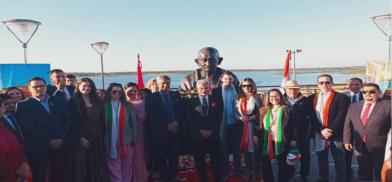Indian outreach to Latin America and Caribbean: Needed more frequent and diversified interactions
India should also project the values and aspirations of the Indo-Pacific into Atlantic waters to help global development. The SAGAR (Security And Growth for All in the Region) model can be extended to a much larger canvas of mutual cooperation and benefit

The renewed effort by the Indian government - and particularly the Ministry of External Affairs - to reach out once again to the Latin American and Caribbean (LAC) countries is indeed most commendable. The visit to Brazil, Paraguay and Argentina by External Affairs Minister S Jaishankar should not only give impetus to bilateral ties and to new diplomatic relationships but also give a fillip to the cooperation among groups such as IBSA (India, Brazil, and South Africa), which has been languishing in the shadow of BRICS, but create new trade, investment and supply chain opportunities for enterprising businessmen and youth for both sides from Mexico to Chile.
There is much to learn from the efforts there to develop themselves in every way as well as opportunities for mutual support in development. All the countries have been staunch supporters of the Non Aligned Movement (NAM) and much political goodwill exists there for India to capitalize on to be a voice of the Global South.
The outreach is also relatively easy as only Spanish and Portuguese languages are required to communicate effectively. Both have many speakers and students in India. Despite the distance, there have been past contacts which have particularly influenced the cuisine of Mexico.
There have been more recent cultural contacts, such as of Argentina with Rabindranath Tagore and the influence of Indian decolonization upon their liberation movements, including of the ideals and techniques of Mahatma Gandhi. There are interesting flight options, too, such as from Mumbai to Sao Paulo via Johannesburg as well by Air India via Frankfurt.
The Internet, of course, makes distances disappear, including via social media. Some countries are included with India in the G-20, while all are in the G-77. India is a member of Mercosur and the Andean Group, which can facilitate trade and economic links.
Pathbreaking work
Indian B2B, B2C and people to people interactions can be facilitated by the excellent government to government relations we enjoy with the LAC countries. Of course, some facilitation and incentivization will be necessary for our entrepreneurs and youngsters to look for business and professional opportunities there.
Companies like TCS, Kirloskar and others have done pathbreaking work in the region. Our businessmen must realize that trading at high margins is not very likely to succeed. Neither is there a widespread Indian diaspora to create trading relationships with. The LAC countries, like Africa, are seeking Indian investment and technology for value addition to local produce. Their view of India is that of a technology innovation and manufacturing leader of the Global South, a successful and thriving democracy achieving high growth in the midst of the largest ethnic and cultural diversity on the planet, with good social and industrial infrastructure.
To encourage traders and shorten supply chains from India, the Finance Ministry and Reserve Bank of India (RBI) may encourage bonded warehousing at strategic locations in LAC, lengthen the time for realization of export proceeds and designate export invoices in Indian rupees rather than hard currencies so that buyers are shielded from currency fluctuations while India realizes the full export value.
Investment in shopping malls of Indian goods in major cities may also promote sales and quicken turnover. The lengthening by RBI of the period of realization of export proceeds from 180 days to 360 days will also reduce the market risk for our entrepreneurs. Investments in small and medium industries in LAC should be incentivized so that Indian investors can train and upskill local labour to produce exportables for the global market where they enjoy LDC and ACP (Lome Convention) advantages. Semi-finished Indian exports may be readied there for sale. ICT and financial services may be given special impetus
Some poorer countries such as Haiti and El Salvador may need special grants for some time for developing basic infrastructure and other services.
Sensitising young Indians
Young Indians graduating from universities need to be encouraged to consider these sunrise markets in Latin America as well as African countries for professional opportunities and start-ups. Lack of awareness and adequate support is preventing our entrepreneurs, professionals and young people from exploring these new and emerging markets on distant shores.
Indian cultural content such as cinema and performing arts have always been popular in the LAC countries. Special efforts may be made to promote them for commercial returns. Education and capacity building must be our basis for non-exploitative cooperation countries like Suriname, Panama, Colombia, Ecuador, Peru, Trinidad & Tobago, Brazil, Argentina, Mexico, Chile, Cuba, Jamaica and Dominica to name only a few, can be excellent bases for Indian business with the whole of America's.
Increasing local employment, especially in Central America, will reduce the northward migration of refugees. India should also project the values and aspirations of the Indo-Pacific into Atlantic waters to help global development. The SAGAR (Security And Growth for All in the Region) model can be extended to a much larger canvas of mutual cooperation and benefit.
Jaishankar's visit should be a forerunner of a more frequent and diversified interaction at B2B, B2C and P2P levels with the LAC countries, if India is to gain the support of LAC on the world stage,
(The author is a former Indian ambassador. Views are personal)









Post a Comment